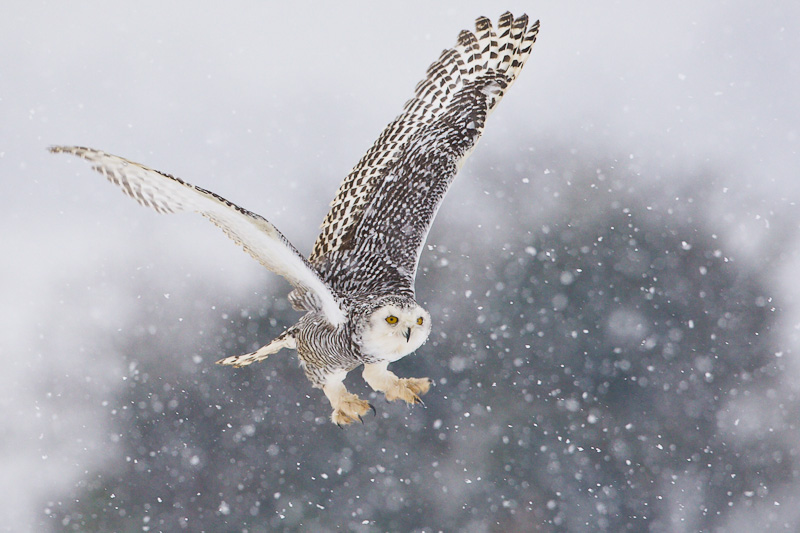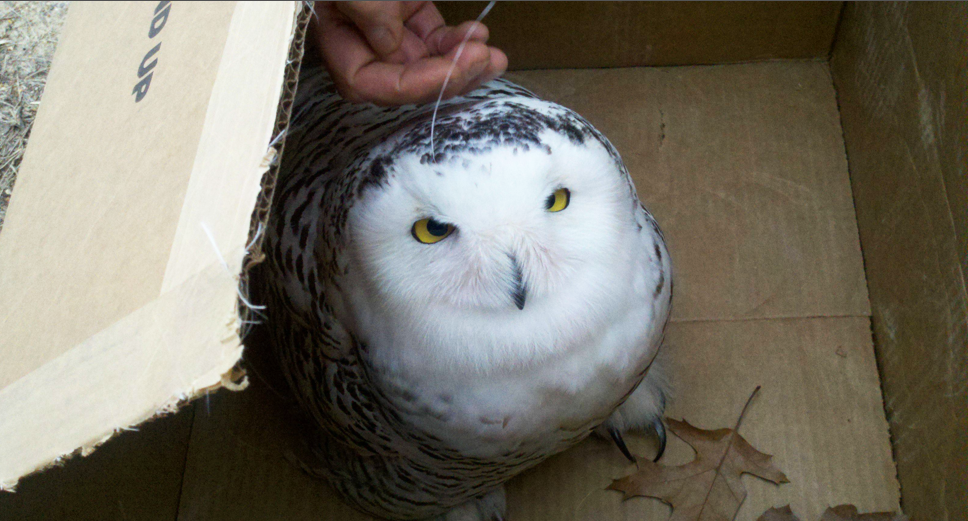
Snowy owl in flight. You might see one in Harriman State Park, but for your best sighting opportunity, head for the shores.
Can you find a snowy owl in Harriman State Park?
It’s called an “irruption”: a sudden and voluminous influx of birds to areas outside their common range. It’s happening now, as beautiful, crystal-white male snowy owls and their brown-barred female counterparts drift south of their Arctic range for a 2013 invasion, producing more sightings in the Northeast, especially New Jersey, Delaware, Maryland, and Virginia.
Can you find a snowy owl in Harriman State Park?
Probably not. The snowy owl likes his landscape wide and barren, and this is why they are bedeviling the open runway areas of JFK airport (which promptly responded to the irruption by shooting several of the owls).
They’ve also been spotted in greatest number along the wide open habitats of Long Island Sound beaches, and further south on the Jersey Shore.

This snowy fella was found with a broken wing, and turned over to the Department of Wildlife Conservation for rehabilitation. The person who discovered this bird admits to petting him. :0)
And that wide-open grassland is a type of landscape that’s hard to find in Harriman, and while Harriman’s hemlock stands and upland hardwood forests are great for great horned owls, they’re not so hot for the snowies.
But that doesn’t mean it’s not worth keeping an eye out for a snowy owl in the park. The most likely landing spot for snowy owls in Harriman might be the flat open grassland of Iona Island, that juts out into the Hudson just below Bear Mountain. Or search the barren hilltop fields along the Ramapo-Dunderberg or Timp-Torne trails, or the edges of the lakes and fields, places like Elk Pen and the grassy verges near Lake Welch.
Here are some tips to help the general search, outside Harriman. The Cornell Lab of Ornithology suggests starting with the beaches first:
“Snowy Owls are often found on beachfronts, and even piers and buildings along lake edges. They often focus on hunting ducks, coots, alcids and other waterbirds, so places these birds concentrate may help you locate one. Beachfront areas with sand dunes are among the best areas to find them.”
Not far from Harriman, in Orange, New York (just north of Warwick), at least one snowy owl has settled in and has been spotted on different days, by different birdwatchers, in the area around Skinners Lane and Pumpkin Swamp Road. This is “black dirt” country — onion fields — and is characterized by low-lying, nearly treeless farmland and field.
Another tip: you can use the very-helpful website ebird.com to find the most recent spottings of these birds by using the map of distribution. Here’s a link to the snowy owl distribution map (you can change the date range to find the most current snowy owl reports for your area).
The Cornell Lab of Ornithology offers these tips to help you spot the snowy:
“Scan snowy flat areas and be on the lookout for any irregularities in the snow. A lump or dirty patch could be a Snowy Owl facing away from you. Snowy Owls like to perch in conspicuous areas, so be sure to check high points like hay bales, fenceposts, telephone poles, buildings, or grain elevators. Also look for agitated birds—other raptors or gulls may swoop at a Snowy Owl sitting on a beach.”
Enjoy the invasion!



a) October 2015 clearly observed magnificent male Snowy Owl “scouting” on the branch of a tree abutting Palisades Parkway, Southbound, 800 ft from Bear Mountain Circle exit ramp. This location is in Palisades Park, approximately two miles from Iona Island. b) Fall 2012, headed southbound Palisades Parkway, when a tan Mountain Lion, or Cougar, bounded across the double southbound lanes, then the double northbound lanes, body fully extended, into Bear Mountain Park. Clearly observed, only 100 feet from the front of our moving car. This location is 100 ft. south of the “Visitor Center Bookstore”. c) Fall 1999, 6:00 a.m., Hancock, NY observed for 10 minutes from kitchen window, a black panther, sitting and licking its front paw in a relaxed fashion, acting just like a domestic house cat. This location is a rural, small community on a dead end street, abutting state lands. The evening before, it had rained. We visited hardware store in an attempt to acquire a mold of its paw print using Quick Crete, but only found what appeared to be one half an imprint, which failed our intention to report sighting to DEC. d) Late July 2017: observed approximately 6-8 mo old black bear, jogging along Route 9W, in grassy island, on West side, across road from St. Luke’s Hospital, Cornwall. Trailed slowly with hazard lights on, then at stop light called local PD. Bear jogged behind house in community and entered wooded area on west side of Rte. 9W 2,000 yards from hospital.